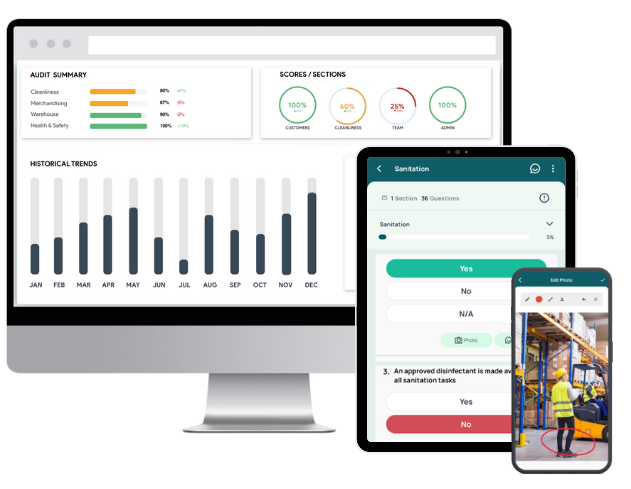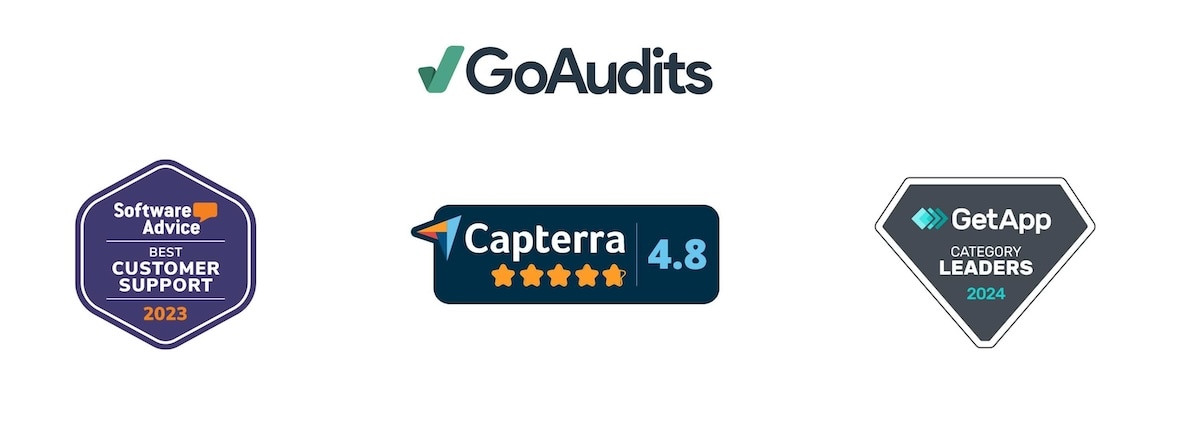An effective environmental management system (EMS) is essential for sustainability and regulatory compliance. It helps you manage environmental performance, reduce their impacts, and meet legal obligations. However, implementing and maintaining an EMS manually presents several challenges. Paper-based processes and spreadsheets often lead to data silos, inconsistent documentation, and delayed reporting, hindering compliance and increasing the risk of non-conformance during audits. ISO 14001 software can overcome these challenges by streamlining EMS implementation, simplifying audit preparation, automating reporting, and ensuring real-time compliance tracking.
This article will compare the top ISO 14001 software, including their features and benefits. We have also listed points you should consider when choosing the best software, along with free checklists to enhance your EMS.
Top 5 ISO 14001 Software in 2025
Here’s a comprehensive guide to the top 5 ISO 14001 software in 2025.
1. GoAudits ISO 14001 Software
GoAudits is an all-in-one ISO 14001 auditing platform designed to simplify environmental compliance through automation, mobility, and intelligent insights. Designed to streamline compliance processes, it replaces paper-based inspections with a mobile-first solution. With GoAudits ISO compliance software, you can accelerate inspection processes, and maintain high standards through data-driven decisions and seamless task management. Its intuitive and user-friendly mobile app and real-time features support organizations striving for environmental excellence by enabling thorough, consistent, and accountable audits.

Key features of GoAudits ISO compliance software:
- Access a wide range of ISO 14001-compliant checklists, customize them, build your own easily using a drag-and-drop interface, or let us do it for you at no additional cost. You can even digitize your ISO SOPs into actionable checklists.
- Conduct audits using smartphones or tablets, even offline. Capture data on the go with ease with the GoAudits mobile ISO app which requires no extensive training.
- Attach annotated photos, collect e-signatures, record timestamps, and log locations for full accountability and traceability.
- Automatically generate comprehensive reports, including attached photos, assigned actions, time stamps, geolocation data, etc., right after each inspection.
- Customize report layouts and add company-specific cover pages for professional presentation. Share reports instantly via email to relevant stakeholders.
- Assign follow-up actions during the inspection process. Clearly define responsibility, priority, and deadlines for each issue.
- Enable task owners to update progress, request clarification, or escalate when needed. Track resolution status to maintain accountability and compliance.
- Set automated workflows for task assignments, approvals, and report distribution. Use automatic notifications to keep team members informed and aligned.
- Visualize inspection outcomes with real-time dashboards. Analyze trends, recurring issues, and historical performance at a glance.
- Centralize all audits and actions in one dashboard to ensure timely completion. Filter data by location, team, audit type, or timeframe for granular insights.

Free & Customizable ISO 14001 Checklists
GoAudits offers various ISO 14001 checklists to conduct internal checks and prepare for official external inspections. You can sign up for free and start using these ISO audit checklists today:
- ISO 14001 Internal Audit Checklist
- ISO 14001 Self-Assessment Checklist
- ISO 14001 Requirements Checklist
2. EHS Insight
EHS Insight is designed to help you achieve and maintain ISO 14001 certification. It streamlines every stage of environmental management. EHS Insight supports your EMS efficiently and effectively by centralizing data, eliminating manual processes, and aligning your operations with ISO 14001 standards. With built-in capabilities for audits, inspections, training, and regulatory oversight, it reduces administrative overhead and enhances your organization’s environmental performance.
Key features of EHS Insight:
- Identify environmental aspects and assess their impacts across all sites.
- Define environmental goals, assign tasks, allocate resources, and monitor progress.
- Connect your ISO 14001 program with other EHS modules to eliminate data silos.
- Ensure your workforce meets EMS responsibilities and maintains compliance with mandatory training and completion tracking.
- Demonstrate conformance with ISO 14001 by generating detailed reports and real-time dashboards.
- Reduce the risk of non-compliance by monitoring compliance tasks and maintaining documentation.
3. Intelex
Intelex Environmental Aspects and Impacts Management Software helps you implement a consistent and efficient process for recognizing environmental aspects, assessing the impacts of your operations, and managing associated risks. Intelex centralizes your environmental data and aligns it with regulatory and internal standards, enhances visibility, supports informed decision-making, and strengthens your organization’s environmental performance.
Key features of Intelex:
- Detect significant environmental aspects and quantify impact severity and likelihood.
- Configurable templates, workflows, and automated tracking.
- Consolidate all environmental aspects and impacts in one platform.
- Accurate and relevant risk management.
- Attach internal controls directly to each activity to ensure regulatory compliance.
- Integrate environmental risks into a broader risk register for a unified view of organizational exposure.
- Generate reports and insights and track environmental performance over time.
4. Quentic
Quentic is tailored for organizations implementing and maintaining an ISO 14001:2015 EMS. Quentic enables seamless environmental data management, efficient resource monitoring, and streamlined compliance reporting. It provides structured workflows, automated indicators, and real-time evaluations. You can make data-driven decisions, track performance trends, and drive continuous improvement in line with your environmental objectives.
Key features of Quentic:
- Consolidate resource consumption, waste, emissions, and cost data for better traceability and analysis.
- Generate detailed charts, performance indicators, and structured evaluations.
- Access accurate, real-time data to identify trends and implement effective environmental strategies.
- Manage environmental, health, safety, quality, and sustainability aspects from one unified platform.
- Facilitate participation across departments and locations through accessible and transparent workflows.
5. GlobalSuite
GlobalSuite ISO 14001 Software is designed to manage and improve your EMS. You can centralize information, automate routine tasks, and integrate environmental practices seamlessly into your organizational processes. It ensures consistency, efficiency, and strategic alignment by consolidating systems and reusing shared data across ISO standards. It supports the full lifecycle of EMS management: from planning and risk assessment to performance evaluation and corrective actions.
Key features of GlobalSuite:
- Monitor compliance, manage documentation, and assess environmental risks from a unified dashboard.
- Automated reporting, updates, and performance dashboards.
- Implement and manage multiple ISO standards concurrently, using a shared framework.
- Define environmental objectives, targets, and scope, aligning EMS strategy with organizational goals.
- Identify, evaluate, and control environmental aspects and hazards.
- Track KPIs and metrics to evaluate EMS effectiveness.
- Develop training plans to promote environmental awareness and ensure ongoing competence across the organization.
| Pricing | Free Trial | |
| GoAudits | $10 per user per month when billed annually | ✅ |
| EHS Insight | Starting at $4,600 per year | ✅ |
| Intelex | $49 per user per month when billed annually | ✅ |
| Quentic | Not available | Demo available |
| GlobalSuite | Not available | Demo available |
What is ISO 14001 Software?
ISO 14001 software is a digital solution designed to help you implement, manage, and maintain an environmental management system (EMS) in line with the ISO 14001 standard. This standard focuses on environmental performance, and this software automates compliance tasks, streamlines data collection, manages documentation, and tracks environmental objectives. You can also identify environmental risks, monitor legal obligations, conduct audits, and drive continual improvement. It ensures transparency, accountability, and traceability across all EMS processes.
Here’s who can benefit from this software:
- Manufacturing companies
- Construction firms
- Energy and utility providers
- Logistics and transportation sectors
- Public sector organizations
- Multinational corporations
Yes, ISO 14001:2015 is still valid as of June 2025. This standard is the globally recognized framework for environmental management systems. It was last comprehensively revised in 2015 and confirmed as current in a 2021 review. ISO continuously reviews and updates this standard, and a new revision is expected in 2025.
What are the Benefits of ISO 14001 Software?
Here are some of the benefits of using ISO 14001 software:
- Simplifies the setup and execution of your environmental management system through automation, centralized control, and structured workflows.
- Helps you stay aligned with legal and regulatory environmental requirements by tracking obligations, audits, and corrective actions in real-time.
- Identifies, assesses, and mitigates environmental risks proactively, reducing the likelihood of incidents and liabilities.
- Minimizes resource consumption, waste, and penalties through optimized processes, leading to measurable financial benefits.
- Eliminates manual tasks, reduces duplication, and standardizes processes, which enhances team productivity and decision-making.
- Provides accurate, real-time data and automated reporting tools that support internal reviews and external audits effortlessly.
- Facilitates regular performance reviews and updates, helping you adapt to change, innovate processes, and stay ahead in your industry.
Key Features to Look for in ISO 14001 Software
When selecting ISO 14001 software, focus on features that streamline compliance, enhance environmental performance, simplify ISO 14001 audits, and support your EMS. Below are six essential features you should prioritize.
- Customizable Checklists: Customizable checklists or templates let you tailor audit criteria to your organization’s specific environmental aspects, legal obligations, and operational activities. You can align them with internal policies, regional regulations, or industry standards, ensuring that nothing critical is overlooked during evaluations.
- Mobile Auditing: Mobile auditing allows your team to conduct site inspections using smartphones or tablets. Field data, including photos, notes, and location tags, can be captured instantly. This reduces delays, eliminates paper-based errors, and enhances audit accuracy, even in remote or high-risk environments.
- Instant Report Generation: This feature lets you convert audit findings into structured reports within minutes. It helps you share results with stakeholders promptly and supports faster decision-making. Look for ISO 14001 software that auto-formats reports and includes visual summaries and compliance indicators.
- Corrective and Preventive Action (CAPA): It enables you to log non-conformities, assign root-cause analysis, and track action items through resolution. By formalizing both corrective and preventive actions, you reduce the risk of recurrence and ensure continuous improvement of environmental performance.
- Workflow Automation: It standardizes tasks such as audit scheduling, document approvals, and compliance reminders. It ensures timely execution, reduces administrative workload, and minimizes human error. Choose a platform that lets you configure workflows based on roles, timelines, and escalation rules.
- Data Analytics: Built-in data analytics help you identify patterns, measure performance against KPIs, and forecast trends. This feature supports strategic planning and continuous improvement by converting raw data into actionable intelligence. Prioritize ISO 14001 software that offers customizable dashboards and exportable data formats.
How to Choose the Best ISO 14001 Software?
To make a well-informed decision, focus on features that support compliance, usability, and long-term value. Here’s how to choose the best software for your organization:
Prioritize User-Friendly & Intuitive Interfaces
Ease of use should be your top priority. Complex systems often lead to poor adoption, errors, and inefficiencies. Choose ISO 14001 software with a clean, intuitive dashboard, clear navigation and task prompts, and minimal training requirements. This ensures all team members can use the software confidently.
Ensure Mobile App Offers Offline Functionality
Field operations often take place in areas with limited connectivity. A reliable ISO 14001 software must support full offline capabilities for mobile inspections, audits, or data entry and automatic syncing once reconnected to the internet. This helps maintain productivity and ensures no gaps in data collection.
Look for Budget-Friendly Options
Analyze the total cost of ownership, including monthly or annual subscription fees, hidden costs, and scalability with growing operations. Opt for ISO 14001 software that delivers robust features at a reasonable price point, aligning with your budget without sacrificing compliance or usability.
Check for Positive Customer Reviews
Customer feedback offers valuable insights into real-world performance. Focus on consistent feedback for ease of use, customer support, and reliability, specific use cases relevant to your industry or company size, and independent review platforms, like Capterra, for unbiased opinions. High ratings and favorable experiences often reflect a product that delivers on its promises.
Take Advantage of Free Trials and Demos
Free trials and guided demos help you test core features in real-world workflows, assess the software’s fit for your organizational needs, and engage stakeholders in the decision-making process. Evaluate performance, flexibility, and ease of integration with your existing systems.




